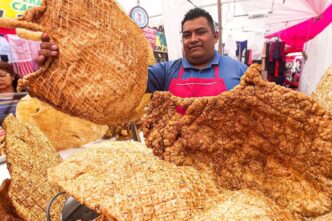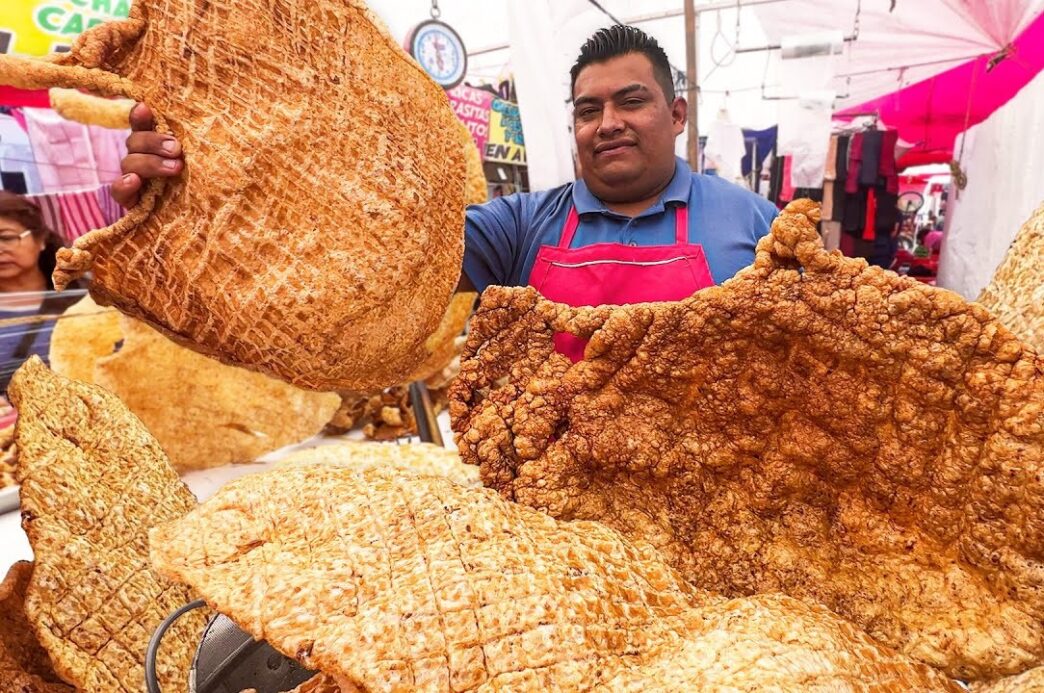In Mexico, nearly every part of the pig is consumed, leading to the creation of traditional dishes such as pozole, which utilizes the bone, lean meat, and head, or cochinita pibil, a Yucatecan dish considered to have pre-Hispanic origins. Carnitas are the quintessential pork dish, especially popular in the states of Michoacán, Jalisco, the State of Mexico, and Mexico City. In fact, a significant portion of the pork production in the latter state is directed specifically toward carnitas consumption. Additionally, we cannot overlook the famous cueritos (pickled pork skin), pressed chicharrón (fried pork rinds), and lard, which serves as a culinary base for dishes like tamales and mole.
The Spanish conquest profoundly altered both the consumption and preparation methods of meat among indigenous peoples. Firstly, the Spanish introduced pork, which, interestingly, was one of the main dishes served at the banquet celebrating the fall of Tenochtitlan. They also introduced livestock such as goats, sheep, cattle, and poultry. Notably, pigs and chickens were quickly incorporated into the indigenous diet; however, beef was initially reserved for Spaniards.
There were even regulations from that era that prohibited the sale of beef to indigenous people during times of scarcity. It wasn’t until 1526 that Mexico City began receiving a regular supply of beef. Furthermore, new cooking methods such as frying and battering were introduced, which popularized the use of pork lard, giving birth to dishes like carnitas. Over time, the consumption and production of meat products like chorizo, ham, blood sausage, and other cured meats flourished during the colonial period, to the point where they are said to have sustained the economy of certain cities.
The history of chicharrón is closely tied to the black population brought to America by Spanish conquerors. These individuals enjoyed raising pigs and, after gaining their freedom, dedicated themselves to pig farming in rural areas. Historical records suggest that chicharrón originated in Santo Domingo, in the Dominican Republic, specifically in the regions near the Isabela and Ozuma rivers, where the Spanish established pig farms that quickly adapted to local cuisine and agriculture. The fusion of cultures led to the incorporation of this ingredient into tamales, adobos, and other traditional dishes. Initially, the goal of making chicharrón was to extract lard. The process involved cutting the pig’s fat into small pieces, seasoning them with salt, water, and meat, then frying them. The fried pork skin released all the lard, which was then strained and stored in jars or cans.
Fried pork skin cooked in lard is known as chicharrón. This crunchy, airy dish can be enjoyed as a snack or incorporated into various recipes. In recent years, it has also gained popularity in keto and high-protein diets due to its long shelf life and ability to be stored in a cool, dry place without refrigeration. The pig skin can be fried with a bit of fat, meat, or completely clean.
If the pig skin is consumed raw, it is not called chicharrón but rather “cueritos,” which are pickled in vinegar and spices, along with brine and sliced vegetables. Cueritos can be eaten as a snack or served with salt, lime, and chili. They are also commonly placed on a crispy flour chicharrón, spread with beans or cream, and topped with cabbage, lettuce, cheese, tomato, avocado, and hot sauce. This popular snack is known as “chicharrón preparado.”
Pressed chicharrón, often found in gorditas, tacos de canasta, or quesadillas, is a derivative of traditional chicharrón. In this preparation, small pieces of pork meat and fried skin are simmered with aromatic herbs or curing salt to give it a reddish hue. The mixture is then drained and pressed to remove excess fat and solidify the ingredients. This preparation is used in various regional dishes, typically made from corn dough or tortillas, and often accompanied by beans or soups.
Pressed chicharron (chicharrón prensado) consists of the scraps left at the bottom of the pots where traditional chicharrón is cooked. Therefore, its texture is softer and slightly chewy due to the pork skin and meat remnants that fry or slightly burn during the chicharrón preparation process.
Chicharrón Guisado (Stewed Fried Pork Rinds) Recipe
Ingredients
2 tablespoons neutral cooking oil such as vegetable or canola
1 medium onion, chopped medium (about 1 cup)
4 medium cloves of garlic, minced (about 4 teaspoons)
2 teaspoons dried Mexican oregano
1 1/2 pounds tomatillos (8 to 10 small), husks removed, quartered
3 medium canned or fresh plum tomatoes (such as Roma or San Marzano), cut into quarters
1 serrano pepper, roughly chopped
2 canned chipotle peppers in adobo sauce
1 cup chopped fresh cilantro leaves and fine stems, plus more to garnish
1 quart (4 cups) homemade or store-bought low-sodium chicken stock (or water)
Kosher salt and freshly ground black pepper
5 ounces store-bought fried pork rinds (chicharrones)
Queso fresco to garnish
Mexican-style crema to garnish (optional)
Directions
Heat oil in a medium pot over medium-high heat until shimmering. Add onions and cook, stirring occasionally, until onions are starting to brown about 8 minutes. Add garlic and oregano and cook, stirring constantly, until fragrant, about 30 seconds. Add tomatillos, tomatoes, serrano pepper, and chipotle peppers. Scrape up any browned bits from the bottom of the pan and reduce heat to medium. Continue to cook, stirring occasionally, until tomatillos and tomatoes are softened and their juices have reduced to a thick sauce-like consistency. Add 2 cups chicken stock (or water), bring to a simmer, and simmer for 5 minutes. Remove from heat.
Transfer the mixture to a food processor. Add cilantro and process until mostly smooth, with an oatmeal-like consistency. Season to taste with salt and pepper.
Return the puréed sauce back to the pot. Add chicharrones and bring sauce to a simmer. Simmer until the chicharrones are tender, 10 to 15 minutes, adding additional stock or water as necessary to adjust the consistency of the liquid. Serve with a choice of garnishes.
With this recipe, you can make tacos, tostadas and even tortas or eat it as is with a side of rice or beans.
I am always happy to hear from you at al**********@***********te.com!



